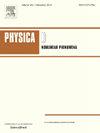Direct linearisation of the non-commutative Kadomtsev–Petviashvili equations
IF 2.7
3区 数学
Q1 MATHEMATICS, APPLIED
引用次数: 0
Abstract
We prove that the non-commutative Kadomtsev–Petviashvili (KP) equation and a ‘lifted’ modified Kadomtsev–Petviashvili (mKP) equation are directly linearisable, and thus integrable in this sense. There are several versions of the non-commutative mKP equations, including the two-dimensional generalisations of the non-commutative modified Korteweg–de Vries (mKdV) equation and its alternative form (amKdV). Herein we derive the ‘lifted’ mKP equation, whose solutions are the natural two-dimensional extension of those for the non-commutative mKdV equation derived in Blower and Malham (2023). We also present the log-potential form of the mKP equation, from which all of these non-commutative mKP equations can be derived. To achieve the integrability results, we construct the pre-Pöppe algebra that underlies the KP and mKP equations. This is a non-commutative polynomial algebra over the real line generated by the solution (and its partial derivatives) to the linearised form of the KP and mKP equations. The algebra is endowed with a pre-Pöppe product, based on the product rule for semi-additive operators pioneered by Pöppe for the commutative KP equation. Integrability corresponds to establishing a particular polynomial expansion in the respective pre-Pöppe algebra. We also present numerical simulations of soliton-like interactions for the non-commutative KP equation.
非交换Kadomtsev-Petviashvili方程的直接线性化
我们证明了非交换Kadomtsev-Petviashvili (KP)方程和一个“提升的”修正Kadomtsev-Petviashvili (mKP)方程是直接线性化的,因此在这个意义上是可积的。非交换mKP方程有几个版本,包括非交换修正Korteweg-de Vries (mKdV)方程的二维推广及其替代形式(amKdV)。在这里,我们推导了“提升”的mKP方程,其解是Blower和Malham(2023)中推导的非交换mKdV方程的自然二维扩展。我们还给出了mKP方程的对数势形式,由此可以导出所有这些非交换的mKP方程。为了得到可积性的结果,我们构造了KP和mKP方程的pre-Pöppe代数。这是由KP和mKP方程的线性化形式的解(及其偏导数)生成的实线上的非交换多项式代数。基于对易性KP方程的Pöppe首创的半加性算子的乘积规则,赋予代数一个pre-Pöppe乘积。可积性对应于在相应的pre-Pöppe代数中建立一个特定的多项式展开。我们也给出了非对易KP方程的类孤子相互作用的数值模拟。
本文章由计算机程序翻译,如有差异,请以英文原文为准。
求助全文
约1分钟内获得全文
求助全文
来源期刊

Physica D: Nonlinear Phenomena
物理-物理:数学物理
CiteScore
7.30
自引率
7.50%
发文量
213
审稿时长
65 days
期刊介绍:
Physica D (Nonlinear Phenomena) publishes research and review articles reporting on experimental and theoretical works, techniques and ideas that advance the understanding of nonlinear phenomena. Topics encompass wave motion in physical, chemical and biological systems; physical or biological phenomena governed by nonlinear field equations, including hydrodynamics and turbulence; pattern formation and cooperative phenomena; instability, bifurcations, chaos, and space-time disorder; integrable/Hamiltonian systems; asymptotic analysis and, more generally, mathematical methods for nonlinear systems.
 求助内容:
求助内容: 应助结果提醒方式:
应助结果提醒方式:


